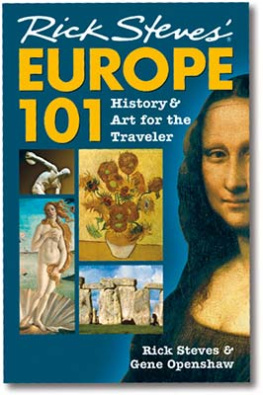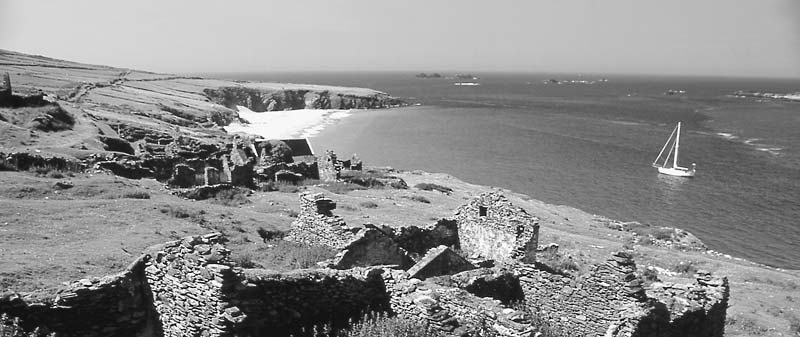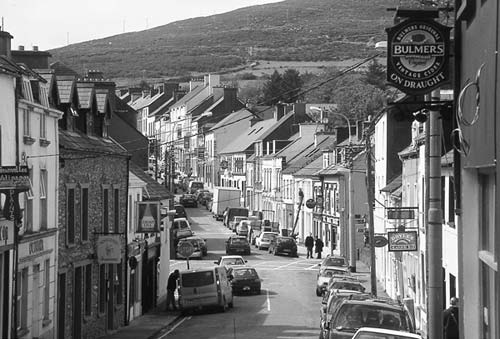Rick Steves
SNAPSHOT
Dingle Peninsula
Rick Steves & Pat OConnor
This Snapshot guide, excerpted from the latest edition of my guidebook Rick Steves Ireland, introduces you to the beautiful Dingle Peninsula, the westernmost part of Ireland where youll find friendly locals that speak the Irish (Gaelic) language. This 10-mile by 40-mile patch of green is the perfect place to bide a while and immerse yourself in Irelands history, scenery, music, and culture.
In Dingle town, shop for local crafts, and spend evenings trawling the pubs for traditional music and good craic (conversation). Take a challenging bike ride (or drive) around the 30-mile Slea Head loop. Archaeological sites from the Neolithic Age through early-Christian times offer thoughtful exploration. Catch a small ferry out to the Blasket Islands to look for puffins, dolphins, and a vanishing way of life. Youll probably enter or leave the Dingle Peninsula through the gateway city of Tralee, which offers a fine museum that tells of 7,000 years of County Kerrys history.
To help you have the best trip possible, Ive included the following topics in this book:
Planning Your Time, with advice on how to make the most of your limited time
Orientation, including tourist information (abbreviated as TI), tips on public transportation, local tour options, and helpful hints
Sights with ratings:
Dont miss
Try hard to see
Worthwhile if you can make it
No ratingWorth knowing about
Sleeping and Eating, with good-value recommendations in every price range
Connections, with tips on trains, buses, and driving
Practicalities, near the end of this book, has information on money, phoning, hotel reservations, transportation, and more.
To travel smartly, read this little book in its entirety before you go. Its my hope that this guide will make your trip more meaningful and rewarding. Traveling like a temporary local, youll get the absolute most out of every mile, minute, and dollar.
Happy travels!
Dingle Town Dingle Peninsula Loop Trip Blasket Islands Tralee
The Dingle Peninsula, the westernmost tip of Ireland (and Europe, for that matter), offers just the right mix of far-and-away beauty, isolated walks and bike rides, and ancient archaeological wondersall within convenient reach of its main town. Dingle town is just large enough to have all the necessary tourist services and a steady nocturnal beat of Irish traditional music.
Although Dingle is crowded in summer, it still feels like the fish and the farm really matter. A dozen fishing boats sail from here, tractors leave tracks down the main drag, and a faint whiff of peat fills the nighttime streets.
For over 30 years, my Irish dreams have been set here on this sparse but lush peninsula, where locals are fond of saying, The next parish over is Boston. Theres a feeling of closeness to the land in Dingle. When I asked a local if he was born here, he thought for a second and said, No, it was about six miles down the road. When I told him where I was from, a faraway smile filled his eyes, and he looked out to sea and sighed, Ah, the shores of Americay. I asked his friend if hed lived here all his life. He said, Not yet.
Dingle feels so traditionally Irish because its part of the Gaeltacht, a region where the government subsidizes the survival of the Irish language and culture. While English is always there, the signs, chitchat, and songs come in Gaelic. Children carry hurling sticks to class, and even the local preschool brags ALL Gaelic.
Of the peninsulas 10,000 residents, 1,500 live in Dingle town (An Daingean). Its few streets, lined with ramshackle but gaily painted shops and pubs, run up from a rain-stung harbor always busy with fishing boats and leisure sailboats. Traditionally, the buildings were drab gray or whitewashed, but Irelands tidy town competition a few decades back prompted everyone to paint their buildings in playful pastels.
Its a peaceful town. The courthouse (1832) is open one hour a month. The judge does his best to wrap up business within a half hour. During the day, youll see teenagersalready working on ruddy beer-glow cheeksroll kegs up the streets and into the pubs in preparation for another night of music and craic (fun conversation and atmosphere).
Planning Your Time
For the shortest visit, give Dingle two nights and a day. It takes six hours to get here from Dublin, Galway, or the boat dock in Rosslare. By spending two nights, youll feel more like a local on your second evening in the pubs. Youll need the better part of a day to explore the 30-mile loop around the peninsula by bike or car (following my Dingle Peninsula Loop Trip in this chapter). To do any serious walking or relaxing, youll need three nights and two days. Its not uncommon to find Americans slowing way, way down in Dingle.
Dingles activity level peaks in July and August and really dies off-season. If youre traveling during the summer months, its wise to reserve your B&B in advance. Ive generally listed hours for the tourist season (April-Sept). Hours may be longer in July and August, and most places cut back or shut down entirely from October to March.
Dingleextremely comfortable on foothangs on a medieval grid of streets between the harborfront (where the bus to Tralee, with the nearest train station, stops) and Main Street (three blocks inland). Nothing in town is more than a 15-minute walk away. Street numbers are used only when more than one place is run by a family of the same name. Most locals know most locals, and people on the street are fine sources of information. Remember, locals love their soda bread, and tourism provides the butter. Youll find a warm and sincere welcome.
Tourist Information
The TI has a great town map (free) and a staff who know the town, but less about the rest of the peninsula (July-Aug Mon-Sat 9:00-18:00, Sun 10:00-17:00, less off-season, on Strand Street by the water, tel. 066/915-1188). For additional advice on outdoor activities, drop by the Mountain Man shop on Strand Street (see Helpful Hints, later), or talk to your B&B host.
Arrival in Dingle
By Bus: Dingle has no bus station and only one bus stop, on the waterfront behind the SuperValu supermarket (look for the bus shelter with the roof made from an overturned black currach boat).
By Car: Drivers choose two roads into town: the easy southern route on N-86 or the much more dramatic, scenic, and treacherous Conor Pass on R-569 (see Route Tips for Drivers, at the end of this chapter). Its 30 miles (48 km) from Tralee either way. If youre not staying overnight (i.e., parking at your B&B), use the waterfront parking lot extending west from the TI (1/hour, pay at meter in lot and display on dashboard, daily 8:00-18:00).













